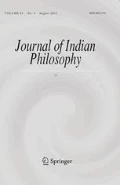REFERENCES
Bhatt, G.P. (1962). Epistemology of the Bhā\(\underset{\raise0.3em\hbox{$\smash{\scriptscriptstyle\cdot}$}}{t} \underset{\raise0.3em\hbox{$\smash{\scriptscriptstyle\cdot}$}}{t} \)a School of Pūrvamīmā\(\underset{\raise0.3em\hbox{$\smash{\scriptscriptstyle\cdot}$}}{m} \)sā. Varanasi: Chowkhamba Sanskrit Studies XVII.
Bhavanātha (1977). Mīmā\({\underset{\raise0.3em\hbox{$\smash{\scriptscriptstyle\cdot}$}}{m} }\)sānayaviveka. Edited with Ravideva's Vivekatattva and Varadarāja's Dīpikā. Delhi: Rā\(\underset{\raise0.3em\hbox{$\smash{\scriptscriptstyle\cdot}$}}{s} \underset{\raise0.3em\hbox{$\smash{\scriptscriptstyle\cdot}$}}{t} \)riya Sā\({\underset{\raise0.3em\hbox{$\smash{\scriptscriptstyle\cdot}$}}{m} }\)sk\({\underset{\raise0.3em\hbox{$\smash{\scriptscriptstyle\cdot}$}}{r} }\)ta Sa\({\underset{\raise0.3em\hbox{$\smash{\scriptscriptstyle\cdot}$}}{m} }\)sthāna.
Clooney, F.X. (1990). Thinking Ritually: Rediscovering the Pūrva Mīmī\({\underset{\raise0.3em\hbox{$\smash{\scriptscriptstyle\cdot}$}}{m} }\)sā of Jaimini. Vienna: Publications of the De Nobili Research Library 17.
Devasthali, G.V. (1959). Mīmā \({\underset{\raise0.3em\hbox{$\smash{\scriptscriptstyle\cdot}$}}{m} }\) sā: The Ancient Indian Science of Sentence Interpretation. Delhi: Sri Satguru Publications, 1991 (2nd revised ed.).
Jaimini (1970–1976). ‘Mīmī\({\underset{\raise0.3em\hbox{$\smash{\scriptscriptstyle\cdot}$}}{m} }\)sāsūtra’, in K.V. Abhyankar and J.A. Joshi (eds.), Mīmā\({\underset{\raise0.3em\hbox{$\smash{\scriptscriptstyle\cdot}$}}{m} }\)sādarŚana. Trivandrum: ĀnandāŚrama Sanskrit Series 97 (7 Vols., 2nd ed.).
Jha, Ganganath (1911). The Prābhākara School of Pūrva Mīmā\({\underset{\raise0.3em\hbox{$\smash{\scriptscriptstyle\cdot}$}}{m} }\)sā. Delhi: Motilal Banarsidass, 1978 (2nd ed.).
Jha, Ganganath (1942). Pūrva-M īmā\({\underset{\raise0.3em\hbox{$\smash{\scriptscriptstyle\cdot}$}}{m} }\)sā in its Sources. Varanasi: Benares Hindu University, 1964 (2nd ed.).
Keith, A.B. (1921). The Karma Mīmā\({\underset{\raise0.3em\hbox{$\smash{\scriptscriptstyle\cdot}$}}{m} }\)sā. Delhi: Munshiram Manoharlal, 1978 (2nd ed.).
Kevalānandasarasvatī (1952–1976). Mīmā\({\underset{\raise0.3em\hbox{$\smash{\scriptscriptstyle\cdot}$}}{m} }\)sākośa (7 Vols.). Delhi: Sir Satguru Publications, 1992 (2nd ed.).
Kumārilabha\(\underset{\raise0.3em\hbox{$\smash{\scriptscriptstyle\cdot}$}}{t} \underset{\raise0.3em\hbox{$\smash{\scriptscriptstyle\cdot}$}}{t} \)a (1970–1976). ‘Tantravārttika’, in K.V. Abhyankar and J.A. Joshi (eds.), Mīmī\({\underset{\raise0.3em\hbox{$\smash{\scriptscriptstyle\cdot}$}}{m} }\)sādarśana. Trivandrum: Ānandāśrama Sanskrit Series 97 (7 Vols., 2nd ed.).
Kumārilabha\(\underset{\raise0.3em\hbox{$\smash{\scriptscriptstyle\cdot}$}}{t} \underset{\raise0.3em\hbox{$\smash{\scriptscriptstyle\cdot}$}}{t} \)a (1970–1976). ‘\(\underset{\raise0.3em\hbox{$\smash{\scriptscriptstyle\cdot}$}}{T} \)up\(\underset{\raise0.3em\hbox{$\smash{\scriptscriptstyle\cdot}$}}{t} \)īkā’, in K.V. Abhyankar and J.A. Joshi (eds.), Mīmā\({\underset{\raise0.3em\hbox{$\smash{\scriptscriptstyle\cdot}$}}{m} }\)sādarśana. Trivandrum: Ānandāśrama Sanskrit Series 97 (7 Vols., 2nd ed.).
Kumārilabha\(\underset{\raise0.3em\hbox{$\smash{\scriptscriptstyle\cdot}$}}{t} \underset{\raise0.3em\hbox{$\smash{\scriptscriptstyle\cdot}$}}{t} \)a (1978). Ślokavārttika. Edited with the Nyāyaratnākara of Pārthasārathimiśra by Svāmī Dvārikadāsa Śāstrī. Varanasi: Tara Publications.
Kunjunni Raja, K. (1963). Indian Theories of Meaning. Madras: Adyar Library and Research Centre, 1977 (3rd ed.).
Mādhava (1989). Jaiminīyanyāyamālāvistara. Delhi: Vrajajīvan Prācyabhāratī Granthamālā 35 (reprint of 1883 Calcutta ed.).
Nakamura, Hajime (1994). ‘Problem of the Categorical Imperative in the Philosophy of Prabhākara School: A Brief Note’, in R.C. Dwivedi (ed.), Studies in Mīmā\({\underset{\raise0.3em\hbox{$\smash{\scriptscriptstyle\cdot}$}}{m} }\)sā. Delhi: Motilal Banarsidass.
Prabhākara (1934). B\({\underset{\raise0.3em\hbox{$\smash{\scriptscriptstyle\cdot}$}}{r} }\)hatī (Tarkapāda). Edited with the \(\underset{\raise0.3em\hbox{$\smash{\scriptscriptstyle\cdot}$}}{R} \)juvimalapañcikā of Śālikanāthamiśra by S.K. Ramanatha Sastri. Madras: Madras University Sanskrit Series 3 (part I).
Prabhākara (1962). B\({\underset{\raise0.3em\hbox{$\smash{\scriptscriptstyle\cdot}$}}{r} }\)hatī. Part II (Adhyāya 1, Pāda 2 – Adhyāya 2, Pāda 4). Edited with the \(\underset{\raise0.3em\hbox{$\smash{\scriptscriptstyle\cdot}$}}{R} \)juvimalapañcikā of Śālikanāthamiśra by S. Subrahmanya Sastri. Madras: Madras University Sanskrit Series 24.
Prabhākara (1964). B\({\underset{\raise0.3em\hbox{$\smash{\scriptscriptstyle\cdot}$}}{r} }\)hatī, Part IV (Adhyāyas 3–5). Edited with the \(\underset{\raise0.3em\hbox{$\smash{\scriptscriptstyle\cdot}$}}{R} \)juvimalapañcikā of Śālikanāthamiśra by S. Subrahmanya Sastri. Madras: Madras University Sanskrit Series 25.
Prabhākara (1967). B\({\underset{\raise0.3em\hbox{$\smash{\scriptscriptstyle\cdot}$}}{r} }\)hatī, Part V (Adhyāyas 6, 9, 10 and 12). Edited with the \(\underset{\raise0.3em\hbox{$\smash{\scriptscriptstyle\cdot}$}}{R} \)juvimalapañcikā of Śālikanāthamiśra by S. Subrahmanya Sastri. Madras: Madras University Sanskrit Series 26.
Śabara (1970–1976). Śābarabhā\(\underset{\raise0.3em\hbox{$\smash{\scriptscriptstyle\cdot}$}}{s} \)ya. In Mīmā\({\underset{\raise0.3em\hbox{$\smash{\scriptscriptstyle\cdot}$}}{m} }\)sādarśana. Edited by K.V. Abhyankar and J.A. Joshi. Trivandrum: Ānandāśrama Sanskrit Series 97 (7 Vols., 2nd ed.).
Śālikanāthamiśra (1961). Prakaran. apañcikā. Edited with the Nyāyasiddhi of Nārāya\(\underset{\raise0.3em\hbox{$\smash{\scriptscriptstyle\cdot}$}}{n} \)abha\(\underset{\raise0.3em\hbox{$\smash{\scriptscriptstyle\cdot}$}}{t} \underset{\raise0.3em\hbox{$\smash{\scriptscriptstyle\cdot}$}}{t} \)a by A. Subrahmanya Sastri. Varanasi: Benares Hindu University Darśana Series 4.
Sastri, Pashupatinath (1923). Introduction to Pūrva Mīmā\({\underset{\raise0.3em\hbox{$\smash{\scriptscriptstyle\cdot}$}}{m} }\)sā. Varanasi: Chaukhambha Oriental Research Studies 9, 1980 (2nd ed.).
Siderits, Mark. (1985). ‘The Prābhākara Mīmā\({\underset{\raise0.3em\hbox{$\smash{\scriptscriptstyle\cdot}$}}{m} }\)sā Theory of Related Designation’, in B.K. Matilal and J.L. Shaw (eds.), Analytical Philosophy in Comparative Perspective. Dordrecht: D. Reidel Publishing Co.
Someśvarabha\(\underset{\raise0.3em\hbox{$\smash{\scriptscriptstyle\cdot}$}}{t} \underset{\raise0.3em\hbox{$\smash{\scriptscriptstyle\cdot}$}}{t} \)a Nyāyasudhā. In Mīmā\({\underset{\raise0.3em\hbox{$\smash{\scriptscriptstyle\cdot}$}}{m} }\)sādarśana. Edited by Mahāprabhulālagosvāmī (4 Vols.). Varanasi: Prācyabhāratī Granthamālā 16, 22, 23, and 32, 1984ff.
Stcherbatsky, Th. (1926). ‘Über die Nyāyaka\({\underset{\raise0.3em\hbox{$\smash{\scriptscriptstyle\cdot}$}}{m} }\)ikā des Vācaspatimiśra und die Indische Lehre vom kategorischen Imperativ’, in Beitrage zur Literaturwissenschaft und Geistesgeschichte Indiens. Bonn: Kommissionsverlag Fritz Klopp, pp. 369–380.
Taber, John (1992). ‘What Did Kumārilabha\(\underset{\raise0.3em\hbox{$\smash{\scriptscriptstyle\cdot}$}}{t} \underset{\raise0.3em\hbox{$\smash{\scriptscriptstyle\cdot}$}}{t} \)a Mean by Svatah. Prāmān. ya’, Journal of the American Oriental Society 112(2): 205–221.
Vācaspatimiśra (1936). ‘Tattvabindu’. in V.A. Ramaswami Sastri (ed.), \(\underset{\raise0.3em\hbox{$\smash{\scriptscriptstyle\cdot}$}}{R} \underset{\raise0.3em\hbox{$\smash{\scriptscriptstyle\cdot}$}}{s} \)iputra Parameśvara's Tattvavibhāvanā. Madras: Annamalai University Sanskrit Series 3.
Verpoorten, JeanMarie (1984). ‘Le nombre Grammatical et son incidence sur l'injonction rituelle. Une Discussion de Śabara et Kumārila à Mīmā\({\underset{\raise0.3em\hbox{$\smash{\scriptscriptstyle\cdot}$}}{m} }\)sāS ūtra II, 1, 13; 14; 15’, Acta Iranica 23: 519–542.
Verpoorten, JeanMarie (1987). Mīmā\({\underset{\raise0.3em\hbox{$\smash{\scriptscriptstyle\cdot}$}}{m} }\)sā Literature (Vol. VI, fasc. 5 in Jan Gonda (ed.), A History of Indian Literature). Wiesbaden: Otto Harrassowitz.
Wicher, Irene (1994). ‘Svargakāma’, Wiener Zeitschrift für die Kunde Südasiens 38: 509–522.
Yoshimizu, Kiyotaka (1994). ‘Der Geltungsbereich der Vedischen Weisung (Niyoga) bei den Prābhākaras’, Wiener Zeitschrift für die Kunde Südasiens 38: 485–507.
Yoshimizu, Kiyotaka (1997). Der ‘Organismus’ des urheberlosen Veda: Eine Studie der NiyogaLehre Prabhākaras mit Ausgew¨ahlten Übersetzungen der B\({\underset{\raise0.3em\hbox{$\smash{\scriptscriptstyle\cdot}$}}{r} }\)hatī. Vienna: Publications of the De Nobili Research Library 25.
Author information
Authors and Affiliations
Rights and permissions
About this article
Cite this article
McCrea, L. The Hierarchical Organization of Language in Mīmāmsā Interpretive Theory. Journal of Indian Philosophy 28, 429–459 (2000). https://doi.org/10.1023/A:1017527826104
Issue Date:
DOI: https://doi.org/10.1023/A:1017527826104

